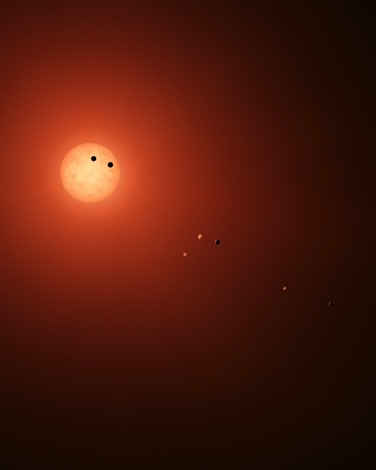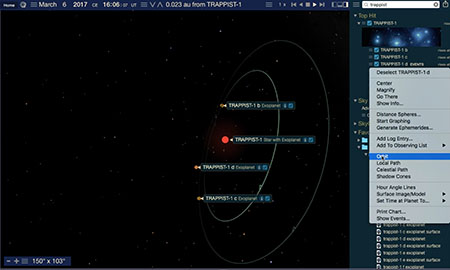In late February 2017, NASA made worldwide news with the extraordinary announcement that around a small, ultra-cool, and relatively nearby star, they found seven rocky Earth-sized planets, all of which could potentially have liquid water given the right conditions. This was the largest batch of Earth-sized planets discovered around a single star.
The new exoplanet system, called TRAPPIST-1, is the first discovery by The Transiting Planets and Planetesimals Small Telescope (TRAPPIST) in Chile, which initially detected three of the planets in May 2016. The TRAPPIST project, operated by the University of Liege in Belgium, uses robotically controlled 60 cm (24”) aperture telescopes to measure tiny variations in a stars’ light produced by orbiting exoplanets that periodically pass in front of the stars and dim their light in a particular way. The orbiting Spitzer Space Telescope, and the Very Large Telescope (VLT) at Paranal, Chile were called upon for further study, and detected the four additional exoplanets.
Several things make this news so exciting. Three of the planets orbit within their star’s habitable zone – the distance from a star that’s not too hot or too cold – where water, if present, could exist in a liquid state on a planet’s surface. Never before have so many planets been detected within the habitable zone of a single star. In fact, it’s possible that liquid water might exist on all 7 planets if the atmospheres of these worlds have the right conditions. Finally, the distance to the system is only 39.5 light-years – putting future study of the planets’ atmospheric compositions within reach of the next generation of telescopes. Detection of oxygen and other biologically-generated gases could reveal an alien eco-system.
Naming an Exoplanet
An exoplanet is named after the star it orbits, followed by a lowercase letter (starting with "b". Progressive lowercase letters are used (c, d, e and so on) when more than one planet is found in a system, with the letters assigned in order of discovery, not distance from the star. The TRAPPIST-1 planets were the exception, they were assigned letters in order of distance after subsequent planets were discovered.
If advanced intelligent life has evolved in the TRAPPIST-1 system, they could already have detected our radio and television transmissions. Our broadcasts of Happy Days, Three’s Company, and Charlie’s Angels are arriving there now. Our own SETI (the Search for Extra-terrestrial Intelligence) has monitored the TRAPPIST-1 system for any artificial radio signals but so far has not detected any alien transmissions. Further surveys however, will be conducted in the future.
While a great many Earth-sized extra-solar planets (exoplanets, for short) have already been catalogued, this discovery brings us another step closer to answering one of the big questions in the universe. Are we alone?

